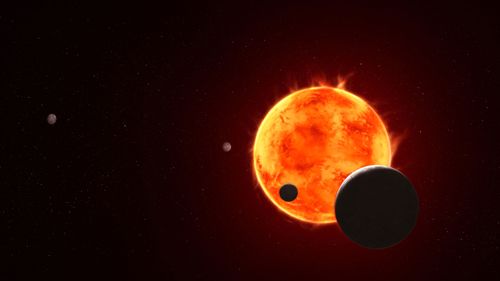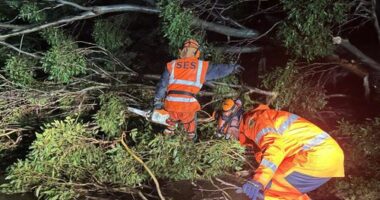Share this @internewscast.com
Astronomers may soon confirm the existence of an Earth-like atmosphere on an exoplanet if further analysis supports early findings from the James Webb Space Telescope.
This exoplanet is part of the TRAPPIST-1 system, located about 40 light-years from Earth, discovered by five Belgian astronomers in 2016. The name was inspired by their favorite beer, and extensive research has followed since.
“As a planetary system, it’s as alien as it gets,” said Néstor Espinoza, an astronomer at the Space Telescope Science Institute in Baltimore.

“TRAPPIST-1e is one of our most intriguing planets in the habitable zone,” stated Sara Seager, a planetary science professor at MIT and coauthor of the studies. “These findings bring us closer to understanding what kind of world it is.”
“The evidence pointing away from Venus- and Mars-like atmospheres sharpens our focus on the scenarios still in play.”
Espinoza noted that his team plans to complete a series of 15 observations by the year’s end, having already finished two-thirds. Should they find definitive evidence of an atmosphere, more observations with the Webb telescope may be carried out to detect chemical signatures of life-associated gases like methane.
Confirmation of an atmosphere would be groundbreaking, Espinoza said.
“It would settle a huge debate going on right now on whether these red dwarf systems can sustain an atmosphere or not,” he said.
“Red dwarfs are the most common stars in the universe. So, if life can occur around them, it could potentially occur anywhere. This greatly expands the possibilities for life.”
Even if an atmosphere is not present, the result would be fascinating, highlighting Earth’s uniqueness. It would pave the way for future studies of exoplanets orbiting yellow dwarf stars like the sun, using even more advanced telescopes currently in development.

Lander’s incredible close-up shot of the moon’s hidden side
Exciting, incomplete results
These first James Webb results for TRAPPIST-1e are immensely exciting, said Michaël Gillon, research director of the Astrobiology Research Unit at Belgium’s University of Liège. Gillon, who led the original discovery of the TRAPPIST-1 system, was not part of the recent study.
“The data are not yet conclusive but they prove that JWST has the power to detect an Earth-like atmosphere if it exists. For the first time in history, we are truly within reach of discovering an atmosphere around a potentially habitable rocky exoplanet,” he said in an email.
The planets in TRAPPIST-1 have a range of conditions similar to the terrestrial planets in our solar system.
These conditions make them potential hosts for surface liquid water, but they require an atmosphere to prevent the water from freezing on the surface or sublimating to space, said Eric Agol, a professor in the department of astronomy at the University of Washington. Agol was not involved with the study but is working on the new set of observations with Espinoza and his colleagues.
TRAPPIST-1 e is the most promising of the seven planets for hosting an Earth-like atmosphere, according to Agol.
“The results are interesting, but also incomplete,” he added in an email.
“I am agnostic about whether TRAPPIST-1 e may have an Earth-like atmosphere or not, and the current study hasn’t affected my opinion.”
According to Howard Chen, an assistant professor of space sciences at the Florida Institute of Technology, TRAPPIST-1e sits right at a “tipping point” between opposite states, based on computer simulations that he detailed in a new study that published Wednesday in The Astrophysical Journal Letters.
Based on its history, the planet can emerge as either extremely dry or water-rich: “That means both ‘bare rock’ and ‘atmosphere-bearing’ scenarios remain physically plausible,” he added in an email. Chen was not involved with the new research.
TRAPPIST-1e could have formed as a desert world, like its inner neighbours, or as a wet, ocean-covered planet, he concluded.
“JWST’s current data can’t distinguish between those scenarios yet, but that ambiguity is exactly what our simulations predict,” Chen said.
“The fact that TRAPPIST-1e can plausibly be either very dry or very wet means the next few JWST (observations) could deliver a dramatic reveal.”













